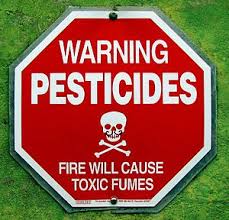 It turns out that another nasty pesticide is found in almost all of us, which we get from the foods we eat. This is the pesticide chlormequat, which is known to have harmful health effects. The use of chlormequat is on the rise in North America and Europe, where it is applied to non-organic grain crops as a plant growth regulator.
It turns out that another nasty pesticide is found in almost all of us, which we get from the foods we eat. This is the pesticide chlormequat, which is known to have harmful health effects. The use of chlormequat is on the rise in North America and Europe, where it is applied to non-organic grain crops as a plant growth regulator.
A recent study found that the percentage of persons with detectable chlormequat in their urine, as well as the levels (concentrations) of chlormequat, have been increasing yearly since 2017 (start of the study), but with a significant increase in 2023. It was found in the urine of 90% of the people tested in 2023.
This is concerning because studies find that it can reduce fertility and harm the developing fetus - even at doses lower than what regulatory agencies view as "allowable daily intake levels". Unfortunately, the CDC does not do biomonitoring of chlormequat in humans - thus it is an under the radar pesticide (found in humans, but no one is officially monitoring it).
Currently it is only allowed on ornamental plants in the US, but in 2023 the EPA proposed allowing the use of chlormequat on barley, oats, triticale, and wheat grown in the US. It is already allowed on imported grain crops from Canada and Europe. One study found it in Quaker oats and oat products, and Cheerios.
In 2020 the US EPA also raised "allowable levels" of chlormequat in food (from 10 ppm to 30 ppm), which is reflected in the study results - 90% of people tested in 2023 had detectable levels of the pesticide in their urine, and in greater amounts (concentrations) than in prior years. Once again the EPA is "looking out for us" - NOT!
Bottom line: Eat as many organic foods as possible, including oats, barley, and wheat. This pesticide is not allowed to be used on organic crops. Changing to an organic diet quickly lowers chlormequat levels in the body.
From Phys.org: New study finds little-known toxic crop chemical in four out of five people tested
A new Environmental Working Group study has found chlormequat, a little-known pesticide, in four out of five people tested. Because the chemical is linked to reproductive and developmental problems in animal studies, the findings suggest the potential for similar harm to humans.
EWG's research, published February 15 in the Journal of Exposure Science and Environmental Epidemiology, tested the urine of 96 people for the presence of chlormequat, finding it in 77 of them.
"EWG's new study on chlormequat is the first of its kind in the U.S.," said EWG Toxicologist Alexis Temkin, Ph.D, lead author of the study. "The ubiquity of this little-studied pesticide in people raises alarm bells about how it could potentially cause harm without anyone even knowing they've consumed it."
Some animal studies show that chlormequat can damage the reproductive system and disrupt fetal growth, changing development of the head and bones and altering key metabolic processes. This research raises questions about whether chlormequat could also harm humans.
For its study, EWG sourced urine samples collected between 2017 and 2023 from 96 people in the U.S. and tested them for chlormequat at a specialized lab in the United Kingdom.
The tests found chlormequat in the urine of more people and at higher concentrations in samples collected in 2023 than in earlier years, suggesting consumer exposure to chlormequat could be on the rise.
Environmental Protection Agency regulations allow the chemical to be used on ornamental plants only—not food crops—grown in the U.S.
But since 2018, the EPA has permitted chlormequat on imported oats and other foods, increasing the allowed amount in 2020. Both regulatory changes took place under the Trump administration. Many oats and oat products consumed in the U.S. come from Canada.
In April 2023, in response to an application submitted by chlormequat manufacturer Taminco in 2019, the Biden EPA proposed allowing the first-ever use of chlormequat on barley, oats, triticale and wheat grown in the U.S. EWG opposes the plan. The proposed rule has not yet been finalized.
"The federal government has a vital role in ensuring that pesticides are adequately monitored, studied and regulated," Temkin said. "Yet the EPA continues to abdicate its responsibility to protect children from the potential health harms of toxic chemicals like chlormequat in food."
EWG urges the Agriculture Department and the Food and Drug Administration to test foods for chlormequat and requests that the Centers for Disease Control and Prevention add chlormequat to its biomonitoring program. The organization also calls for more research on the effects of chlormequat on human health.
EWG conducted its own tests of oat-based foods in 2022 and 2023, finding chlormequat in numerous non-organic oat-based products. Organic oat products had little to no detections of the chemical.
